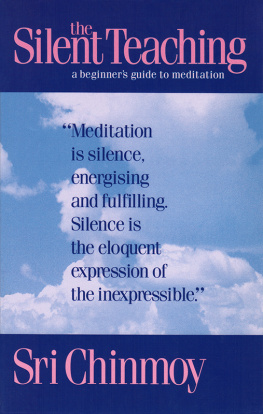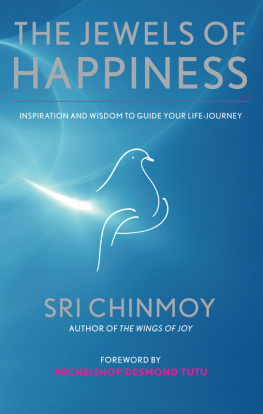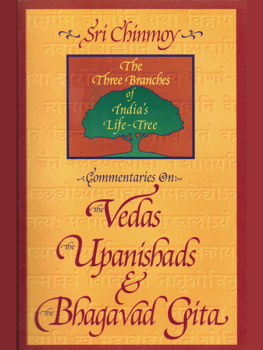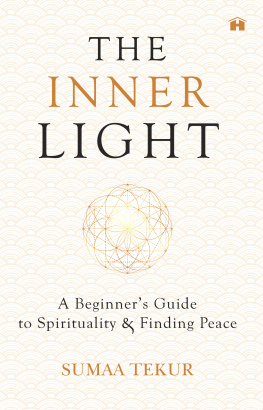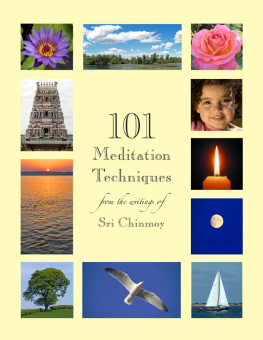Silent Teaching:
a beginners guide
to meditation
by
Sri Chinmoy
With an Introduction by Alan Spence
ISBN: 978-1-938599-61-3
Copyright 1996 Sri Chinmoy
Copyright 2014 Sri Chinmoy Centre (eBook)
All rights reserved. No portion
of this book may be reproduced
in any form without express written
permission from the Publisher.
Published by
Aum Publications
8610 Parsons Blvd.
Jamaica, NY 11432
www.srichinmoy.org
SMASHWORDS EDITION
Contents
INTRODUCTION
The title of this collection, The Silent Teaching, may at first glance seem strange, even paradoxical. To the mind which is accustomed to regard teaching as instruction, or at best practical demonstration, the notion that such a process can be silent, wordless, may be difficult.
Yet in discussing meditation we are moving in a realm where, traditionally, truth is communicated directly, in silence, by a look, a gesture, a touch. (One of the best known examples is Buddhas flower-sermon in which he came to address a large gathering, and his lecture consisted of holding up a flower!) As Sri Chinmoy puts it, All real spiritual Masters teach meditation in silence.
It is not surprising then, that when such masters do use words, the mode is poetic, or paradoxical, or mantric (in which the sound and rhythm of the words actually invoke the qualities described). The aim is always to by-pass the analytical mind and speak directly to that deeper source of awareness which Sri Chinmoy calls the heart.
A book by such a master could never be merely a manual, meditation reduced to techniques. (Though you will find a good deal of practical advice in section three of this volume.)
The techniques suggested by Sri Chinmoy are like springboards for the creative use of the imagination. What you can only imagine today, you will one day discover as real, and eventually you can grow into that reality.
He writes, You have always to create. This creation of yours is something which you ultimately become. Finally you come to realise that your creation is nothing other than your self-revelation.
Sri Chinmoy stresses that there is always more to meditation than techniques, useful though they may be. And that more is essentially the seekers sincere aspiration, the inner cry for the highest.
Aspiration, he writes, is a cry within our heart. The heart is crying and yearning like a mounting flame burning upward. And this gets to the very heart of his teaching, brings out the essential dynamism of his philosophy. Meditation is not simply a passive process, though openness and receptivity are clearly important. What is also required is a positive, creative approach, the upward movement of aspiration.
Meditation shows us how we can aspire for something and at the same time how we can achieve it.
Sri Chinmoy
* * *
The section of this book dealing with the practicalities of meditation comes, as indicated, at the end. The structure, the movement of the book, seems a natural one: from the inspired mystic vision, to the articulation of a philosophy, to practical down-to-earth guidance. It runs the whole range, and includes a selection from some of his most exalted writings on the subject. Here he is operating most clearly in what I described earlier as a mantric mode. Such passages are scriptural in their intensity, and can leave no doubt in the reader that they were written (or rather delivered since they are mostly transcriptions of the spoken word) by a poet and a Master of meditation. They have the true ring of authenticity and contain their own invitation to the silence beyond the words.
Meditation is silence, energising and fulfilling. Silence is the eloquent expression of the inexpressible.
* * *
Sri Chinmoy was born in what was then Bengal, India, in 1931. At an early age he underwent a profound spiritual awakening, attaining a state which he calls God-realisation.
He spent some twenty years in an ashram (spiritual community) before coming to the West in 1964.
Since then he has established a meditation centres all over the world, offering what is very much an integral yoga, combining the spirituality of the East and the dynamism of the West.
Although Sri Chinmoy recognizes that we can never get meditation from books, at the same time, the words of one who has attained the highest realisation can be a tremendous inspiration to those starting out on the journey. For meditation is not something theoretical. It can be thought about, certainly; talked about, yes; but ultimately it has to be practised: A theory must be tested. A fact must be honoured. A truth must be lived.
Alan Spence
THEORY
WHEN
When he concentrates,
Everything matters.
When he meditates,
Nothing matters.
When he contemplates,
Only God matters.
If we feel that we are satisfied with what we have and what we are, then there is no need for us to enter the field of meditation. The reason we enter into meditation is because we have an inner hunger. We feel that within us there is something luminous, something vast, something divine. We feel that we need this thing very badly; only right now we do not have access to it. So our hunger comes from our spiritual need.
Meditation does not mean just sitting quietly for five or ten minutes. It requires conscious effort. The mind has to be made calm and quiet; at the same time, it has to be vigilant so as not to allow any distracting thoughts or desires to enter. When we can make the mind calm and quiet, we will feel that a new creation is dawning inside us. When the mind is vacant and tranquil and our whole existence becomes an empty vessel, our inner being can invoke infinite Peace, Light and Bliss to enter into the vessel and fill it. This is meditation.
When we think that it is we who are trying to meditate, then meditation seems complicated. But real meditation is not done by us. It is done by our inner Pilot, the Supreme, who is constantly meditating in and through us. We are just the vessel, and we are allowing Him to fill us with His whole Consciousness. We start with our own personal effort, but once we go deep within, we see that it is not our effort that is allowing us to enter into meditation. It is the Supreme who is meditating in and through us with our conscious awareness and consent.
* * *
Meditation has to be practised spontaneously, soulfully and correctly. If it is not, dark doubt will blight your mind.
For meditation you need inspiration. Scriptures can supply you with inspiration. To buy a spiritual book takes ten seconds. To read that book takes a few hours. To absorb that book takes a few years. And to live the truths thereof may take not only a whole lifetime, but a few incarnations.
For meditation you need aspiration. The presence, physical or spiritual, of a spiritual teacher can awaken your sleeping aspiration. He can awaken your sleeping aspiration. He can easily and will gladly do it for you. Aspiration: this is precisely what you need in order to reach your journeys goal. You dont have to worry about your realisation. Your aspiration will take care of it.
If you have a teacher who is a realised soul, his silent gaze will teach you how to meditate. A Master does not have to explain outwardly how to meditate or give you a specific form of meditation. He will simply meditate on you and inwardly teach you how to meditate. Your soul will enter into his soul and learn from his soul. All real spiritual Masters teach meditation in silence.
When a realised spiritual Master enters into his highest consciousness, he is one with the Divinity within him. The human individual is entirely merged with the Supreme. At this time, the Masters consciousness is a direct access to the Light which a meditator is searching to uncover in his own heart. The Masters consciousness reveals and offers what the seeker has been working to find deep within himself. To identify with the highest meditation of the Master is to have direct experience of the consciousness which is the Goal of ones inner search. This is not meditation on a human individual, but rather meditation on the Divine Consciousness, which is using the man as an instrument to reveal itself.

